The Lubricity of Ternary Fuel Mixture Blends as a Way to Assess Diesel Engine Durability
Abstract
:1. Introduction
2. Materials and Methods
3. Results and Discussions
3.1. Physiochemical Properties of the Fuel
3.2. Friction Behaviour Analysis
3.3. Wear Characteristics
3.4. Flash Temperature Parameter Analysis
4. Wear Debris and Surface Morphology by SEM/EDX
4.1. Evaluation of Filtered Wear Debris by SEM/EDX
4.2. Wear Surface Analysis by SEM/EDX
5. Conclusions
Acknowledgments
Author Contributions
Conflicts of Interest
References
- Nagar, P.; Miers, S. Friction between Piston and Cylinder of an IC Engine: A Review; SAE Technical Paper; SAE International: Warrendale, PA, USA, 2011. [Google Scholar]
- Mosarof, M.H.; Kalam, M.A.; Masjuki, H.H.; Alabdulkarem, A.; Habibullah, M.; Arslan, A.; Monirul, I.M. Assessment of friction and wear characteristics of Calophyllum inophyllum and palm biodiesel. Ind. Crops Prod. 2016, 83, 470–483. [Google Scholar] [CrossRef]
- Azad, A.K.; Rasul, M.G.; Khan, M.M.K.; Sharma, S.C.; Hazrat, M.A. Prospect of Biofuels as an Alternative Transport Fuel in Australia. Renew. Sustain. Energy Rev. 2015, 43, 331–351. [Google Scholar] [CrossRef]
- Tung, S.C.; McMillan, M.L. Automotive tribology overview of current advances and challenges for the future. Tribol. Int. 2004, 37, 517–536. [Google Scholar] [CrossRef]
- Mosarof, M.; Kalam, M.; Masjuki, H.; Arslan, A.; Monirul, I.; Ruhul, A.; Shahir, S.; Khuong, L. Analysis of thermal stability and lubrication characteristics of Millettia pinnata oil. RSC Adv. 2016, 6, 81414–81425. [Google Scholar] [CrossRef]
- Holmberg, K.; Andersson, P.; Erdemir, A. Global energy consumption due to friction in passenger cars. Tribol. Int. 2012, 47, 221–234. [Google Scholar] [CrossRef]
- Habibullah, M.; Masjuki, H.H.; Kalam, M.A.; Zulkifli, N.W.M.; Masum, B.M.; Arslan, A.; Gulzar, M. Friction and wear characteristics of Calophyllum inophyllum biodiesel. Ind. Crops Prod. 2015, 76, 188–197. [Google Scholar] [CrossRef]
- Uddin, S.M.A.; Azad, A.K.; Alam, M.M.; Ahamed, J.U. Performance of a diesel engine run with mustard-kerosene blends. Procedia Eng. 2015, 105, 698–704. [Google Scholar] [CrossRef]
- Azad, A.K.; Rasul, M.G.; Giannangelo, B. Comparative study of diesel engine performance and emission with soybean and waste oil biodiesel fuels. Int. J. Automot. Mech. Eng. 2015, 12, 2866–2881. [Google Scholar] [CrossRef]
- Azad, A.K.; Rasul, M.G.; Khan, M.M.K.; Sharma, S.C.; Mofigur, M.; Bhuiya, M.M.K. Prospects, feedstocks, and challenges of biodiesel production from beauty leaf oil and castor oil: A non-edible oil sources in Australia. Renew. Sustain. Energy Rev. 2016, 61, 302–318. [Google Scholar] [CrossRef]
- Azad, A.K.; Rasul, M.G.; Khan, M.M.K.; Sharma, S.C.; Islam, R. Prospect of Moringa seed oil as a sustainable biodiesel fuel in Australia: A review. Procedia Eng. 2015, 105, 601–606. [Google Scholar] [CrossRef]
- Bhuiya, M.M.K.; Rasul, M.G.; Khan, M.M.K.; Ashwath, N.; Azad, A.K.; Mofijur, M. Optimisation of oil extraction process from Australian native beauty leaf seed (Calophyllum Inophyllum). Energy Procedia 2015, 75, 56–61. [Google Scholar] [CrossRef]
- Mofijur, M.; Rasul, M.G.; Hyde, J.; Azad, A.K.; Mamat, R.; Bhuiya, M. Role of biofuel and their binary (diesel–biodiesel) and ternary (ethanol–biodiesel–diesel) blends on internal combustion engines emission reduction. Renew. Sustain. Energy Rev. 2016, 53, 265–278. [Google Scholar] [CrossRef]
- Azad, A.K.; Uddin, S.M.A.; Alam, M.M. A comprehensive study of di diesel engine performance with vegetable oil: an alternative bio-fuel source of energy. Int. J. Automot. Mech. Eng. 2012, 5, 576–586. [Google Scholar] [CrossRef]
- Fazal, M.A.; Haseeb, A.S.M.A.; Masjuki, H.H. Investigation of friction and wear characteristics of palm biodiesel. Energy Convers. Manag. 2013, 67, 251–256. [Google Scholar] [CrossRef]
- Haseeb, A.S.M.A.; Sia, S.Y.; Fazal, M.A.; Masjuki, H.H. Effect of temperature on tribological properties of palm biodiesel. Energy 2010, 35, 1460–1464. [Google Scholar] [CrossRef]
- Mosarof, M.H.; Kalam, M.A.; Masjuki, H.H.; Alabdulkarem, A.; Ashraful, A.M.; Arslan, A.; Rashedul, H.K.; Monirul, I.M. Optimization of performance, emission, friction and wear characteristics of palm and Calophyllum inophyllum biodiesel blends. Energy Convers. Manag. 2016, 118, 119–134. [Google Scholar] [CrossRef]
- Azad, A.K.; Rasul, M.G.; Khan, M.M.K.; Omri, A.; Bhuiya, M.M.K.; Hazrat, M.A. Modelling of renewable energy economy in Australia. Energy Procedia 2014, 61, 1902–1906. [Google Scholar] [CrossRef]
- Azad, A.K.; Rasul, M.G.; Khan, M.M.K.; Sharma, S.C.; Bhuiya, M.M.K.; Mofijur, M. A Review on Socio-economic Aspects of Sustainable Biofuels. Int. J. Glob. Warm. 2016, 10, 32–54. [Google Scholar] [CrossRef]
- Azad, A.K.; Uddin, S.M.A. Performance study of a diesel engine by first generation bio-fuel blends with fossil fuel: an experimental study. J. Renew. Sustain. Energy 2013, 5, 1–12. [Google Scholar] [CrossRef]
- Fazal, M.A.; Haseeb, A.S.M.A.; Masjuki, H.H. Comparative corrosive characteristics of petroleum diesel and palm biodiesel for automotive materials. Fuel Process. Technol. 2010, 91, 1308–1315. [Google Scholar] [CrossRef]
- Azad, A.K.; Rasul, M.G.; Khan, M.M.K.; Sharma, S.C. Macadamia biodiesel as a sustainable and alternative transport fuel in Australia. Energy Procedia 2017, 110, 543–548. [Google Scholar] [CrossRef]
- Azad, A.K.; Rasul, M.G.; Khan, M.M.K.; Sharma, S.C.; Bhuiya, M.M.K. Recent development of biodiesel combustion strategies and modelling for compression ignition engines. Renew. Sustain. Energy Rev. 2016, 56, 1068–1086. [Google Scholar] [CrossRef]
- Azad, A.K. Biodiesel from Mandarin Seed Oil: A Surprising Source of Alternative Fuel. Energies 2017, 10, 1689. [Google Scholar] [CrossRef]
- Zulkifli, N.W.M.; Kalam, M.A.; Masjuki, H.H.; Shahabuddin, M.; Yunus, R. Wear prevention characteristics of a palm oil-based TMP (trimethylolpropane) ester as an engine lubricant. Energy 2013, 54, 167–173. [Google Scholar] [CrossRef]
- Maleque, M.; Masjuki, H.; Haseeb, A. Effect of mechanical factors on tribological properties of palm oil methyl ester blended lubricant. Wear 2000, 239, 117–125. [Google Scholar] [CrossRef]
- Pehan, S.; Jerman, M.S.; Kegl, M.; Kegl, B. Biodiesel influence on tribology characteristics of a diesel engine. Fuel 2009, 88, 970–979. [Google Scholar] [CrossRef]
- Hu, J.; Du, Z.; Li, C.; Min, E. Study on the lubrication properties of biodiesel as fuel lubricity enhancers. Fuel 2005, 84, 1601–1606. [Google Scholar] [CrossRef]
- Geller, D.P.; Goodrum, J.W. Effects of specific fatty acid methyl esters on diesel fuel lubricity. Fuel 2004, 83, 2351–2356. [Google Scholar] [CrossRef]
- Syahrullail, S.; Wira, J.Y.; Wan Nik, W.; Fawwaz, W. Friction characteristics of RBD palm olein using four-ball tribotester. Appl. Mech. Mater. 2013, 315, 936–940. [Google Scholar] [CrossRef]
- Havet, L.; Blouet, J.; Valloire, F.R.; Brasseur, E.; Slomka, D. Tribological characteristics of some environmentally friendly lubricants. Wear 2001, 248, 140–146. [Google Scholar] [CrossRef]
- Shuster, M.; Combs, D.; Karrip, K.; Burke, D. Piston Ring Cylinder Liner Scuffing Phenomenon Studies Using Acoustic Emission Technique; SAE Technical Paper; SAE International: Warrendale, PA, USA, 2000. [Google Scholar]
- Azad, A.K.; Rasul, M.G.; Bhuiya, M.M.K.; Islam, R. Effect of first and second generation biodiesel blends on engine performance and emission. AIP Conf. Proced. 2016, 1754, 050031. [Google Scholar]
- Habibullah, M.; Masjuki, H.H.; Kalam, M.A.; Gulzar, M.; Arslan, A.; Zahid, R. Tribological Characteristics of Calophyllum inophyllum–Based TMP (Trimethylolpropane) Ester as Energy-Saving and Biodegradable Lubricant. Tribol. Trans. 2015, 58, 1002–1011. [Google Scholar] [CrossRef]
- Lu, X.; Cotter, J.; Eadie, D. Laboratory study of the tribological properties of friction modifier thin films for friction control at the wheel/rail interface. Wear 2005, 259, 1262–1269. [Google Scholar] [CrossRef]

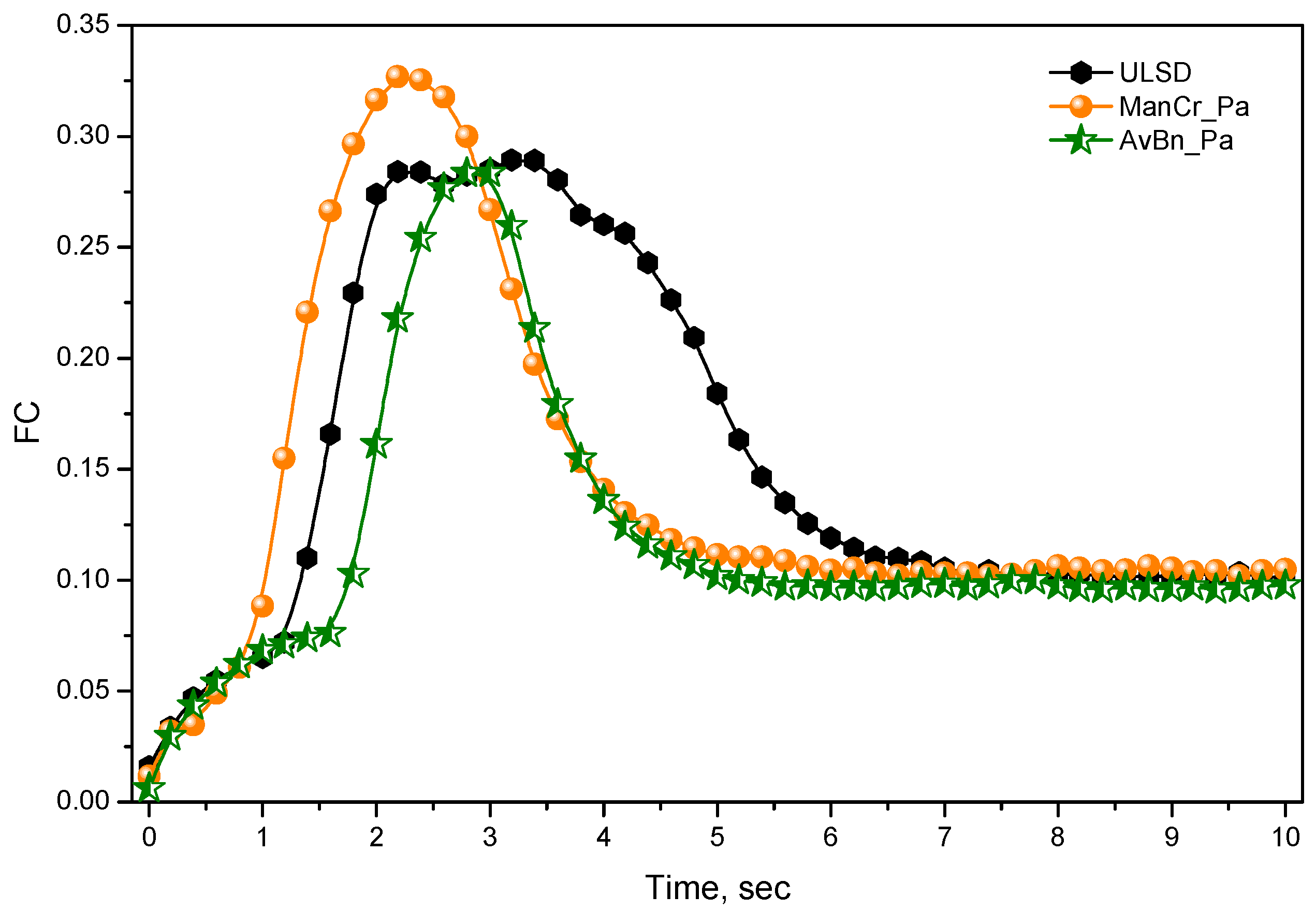
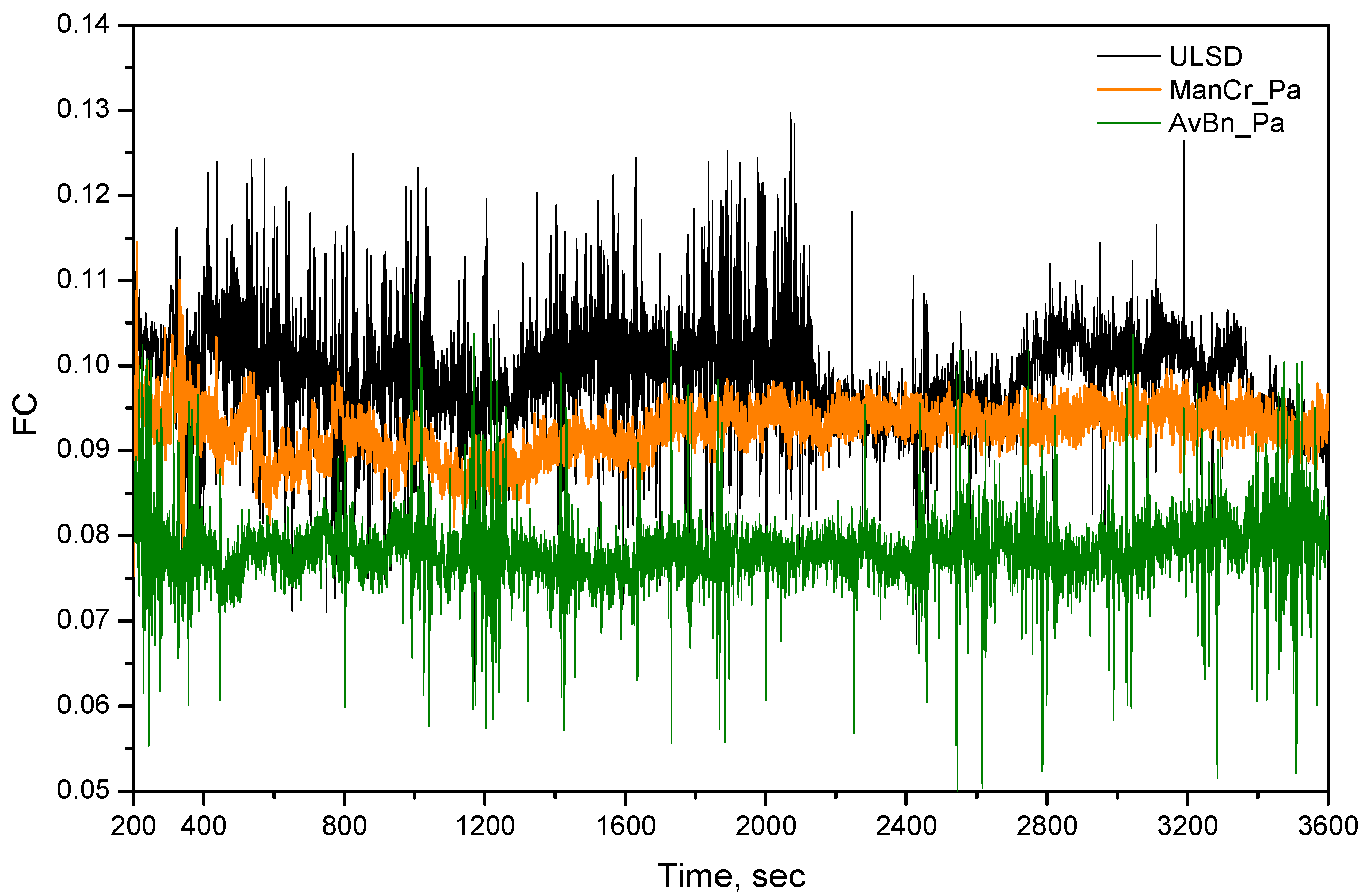
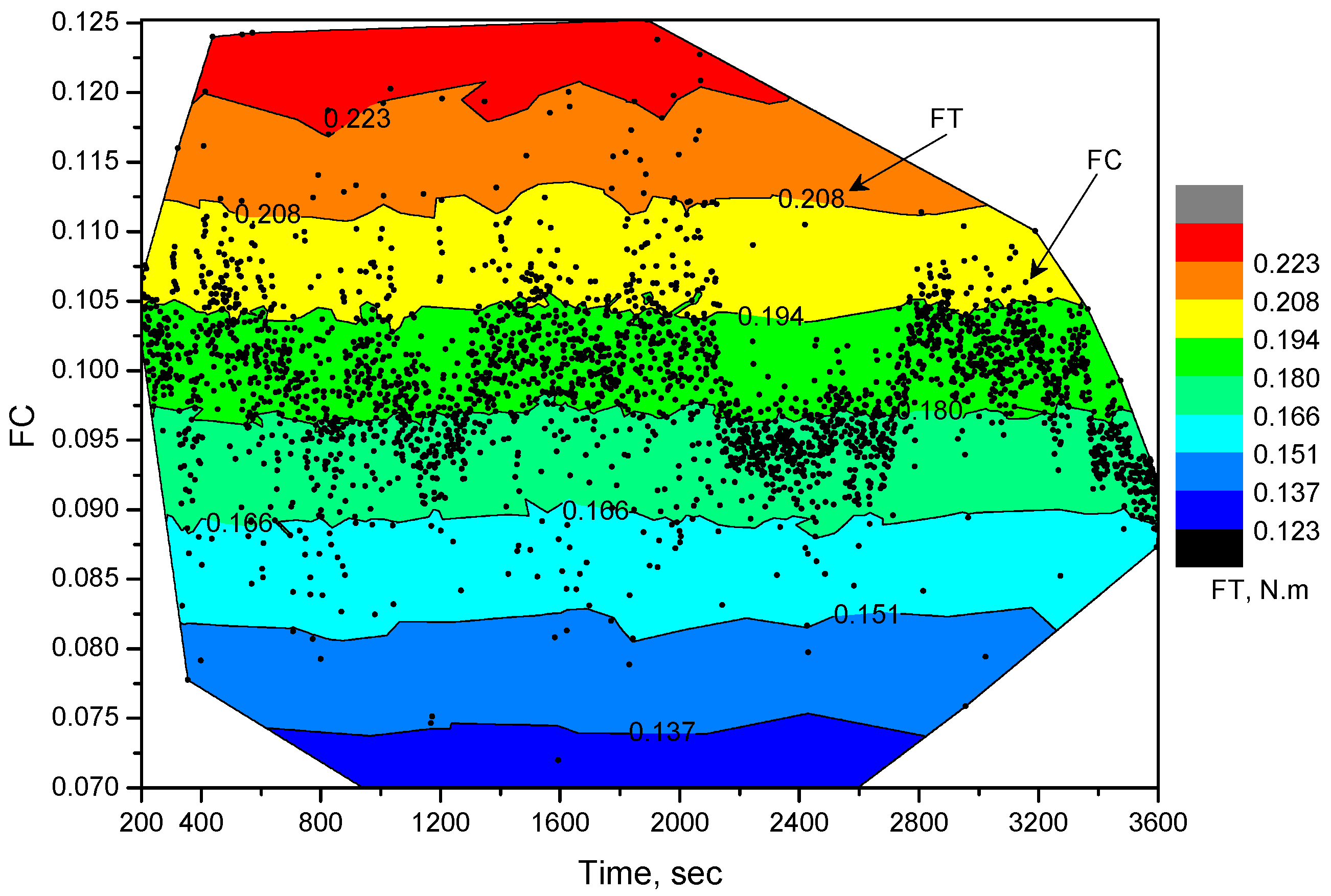
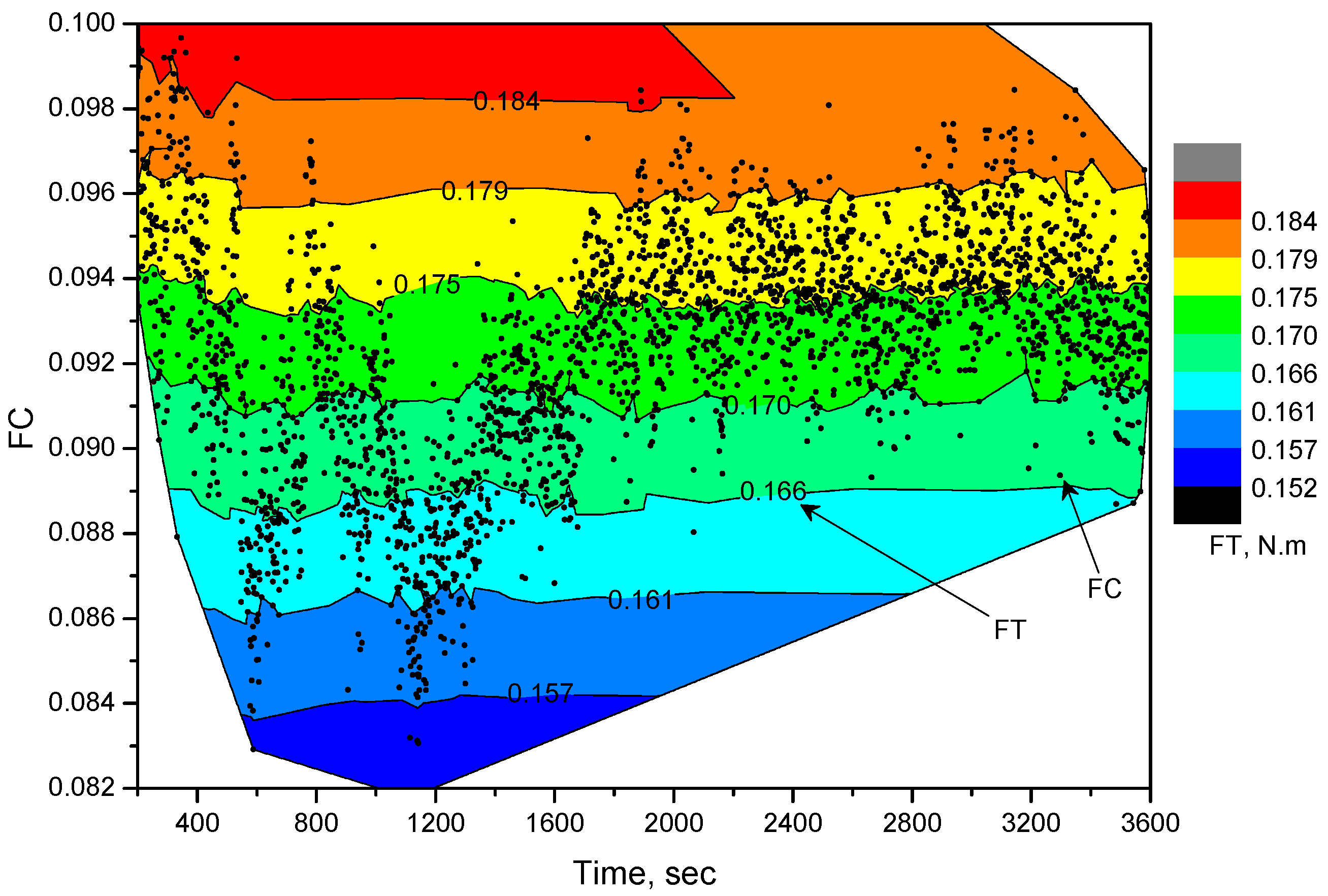
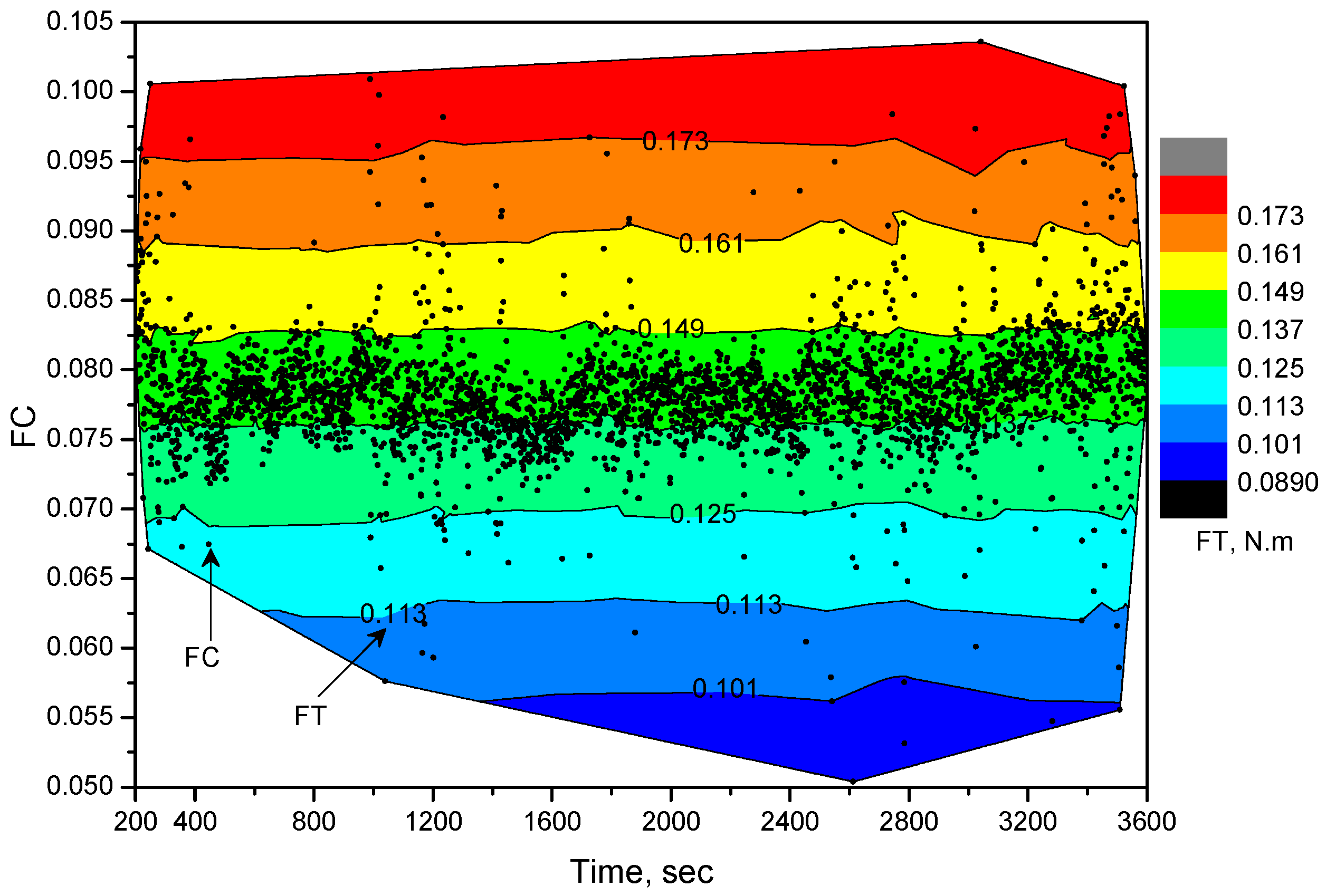
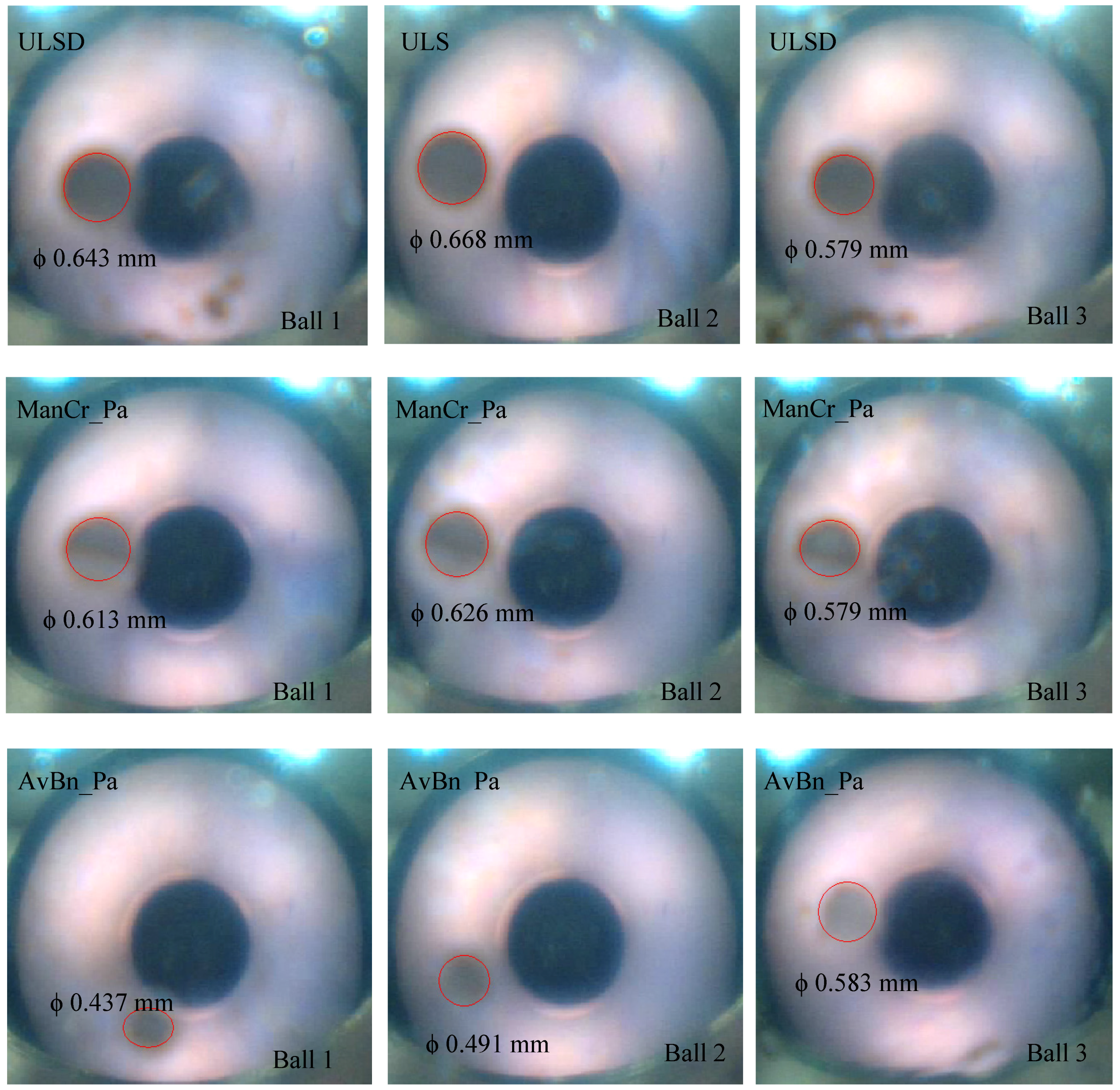
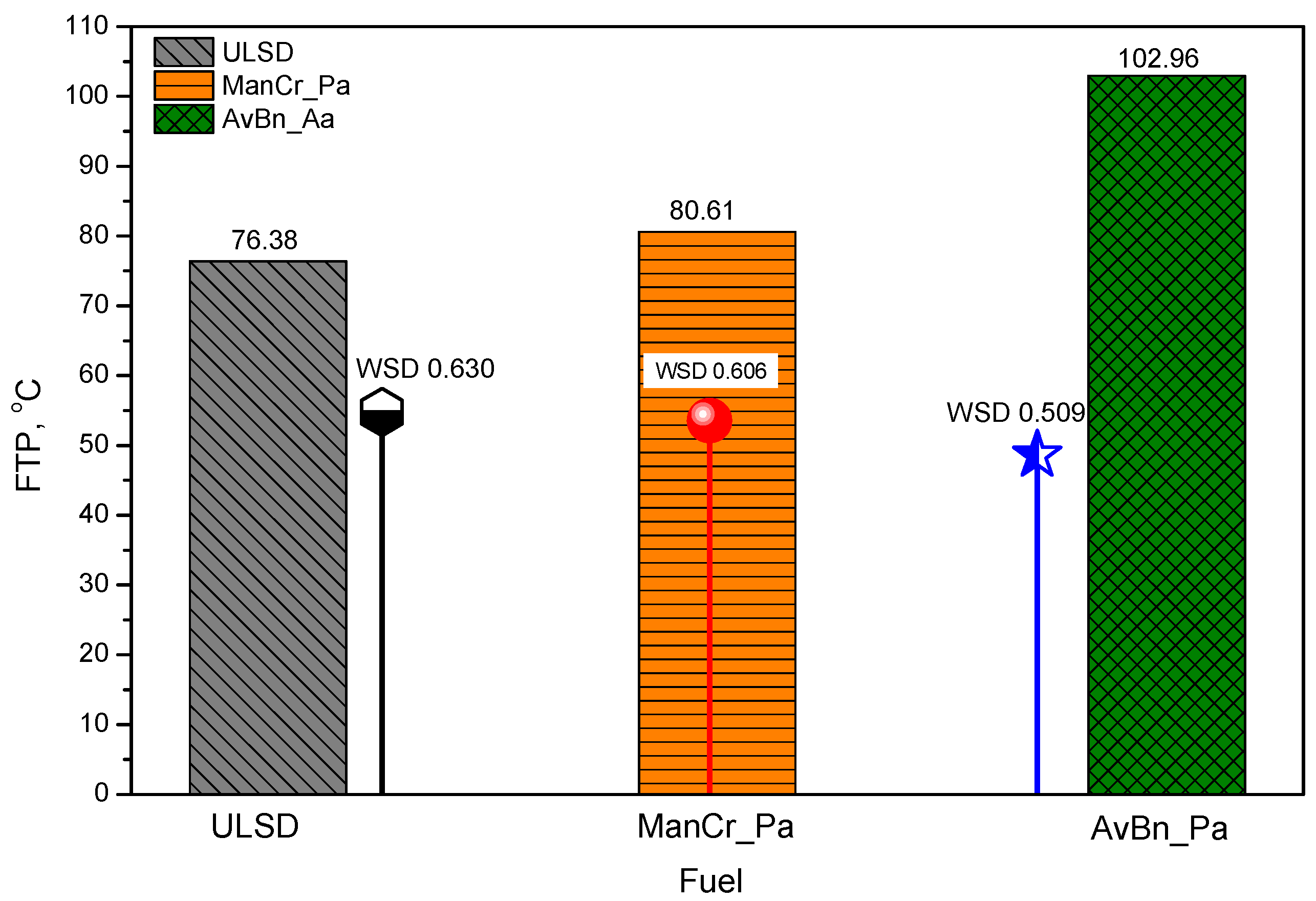

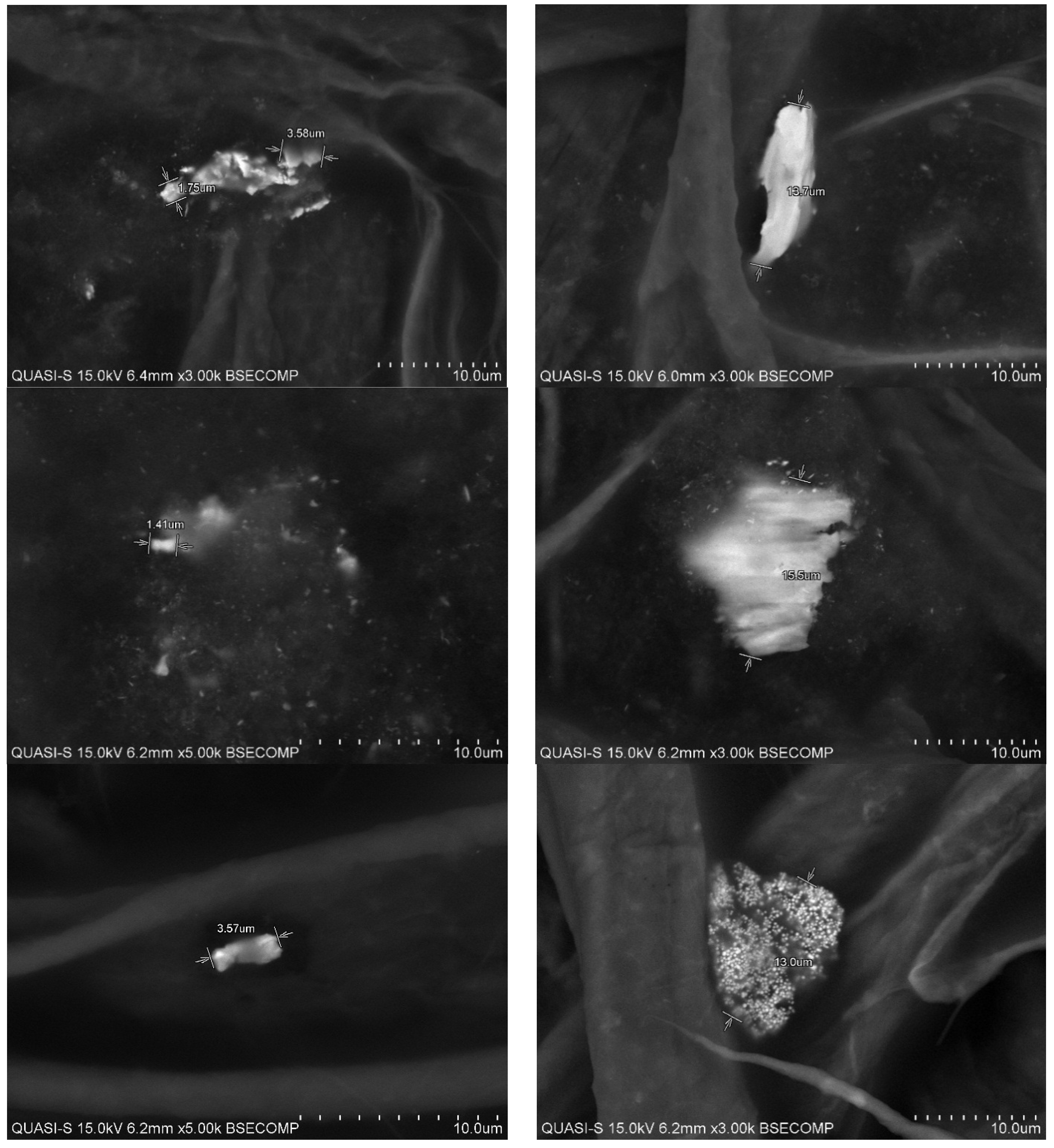
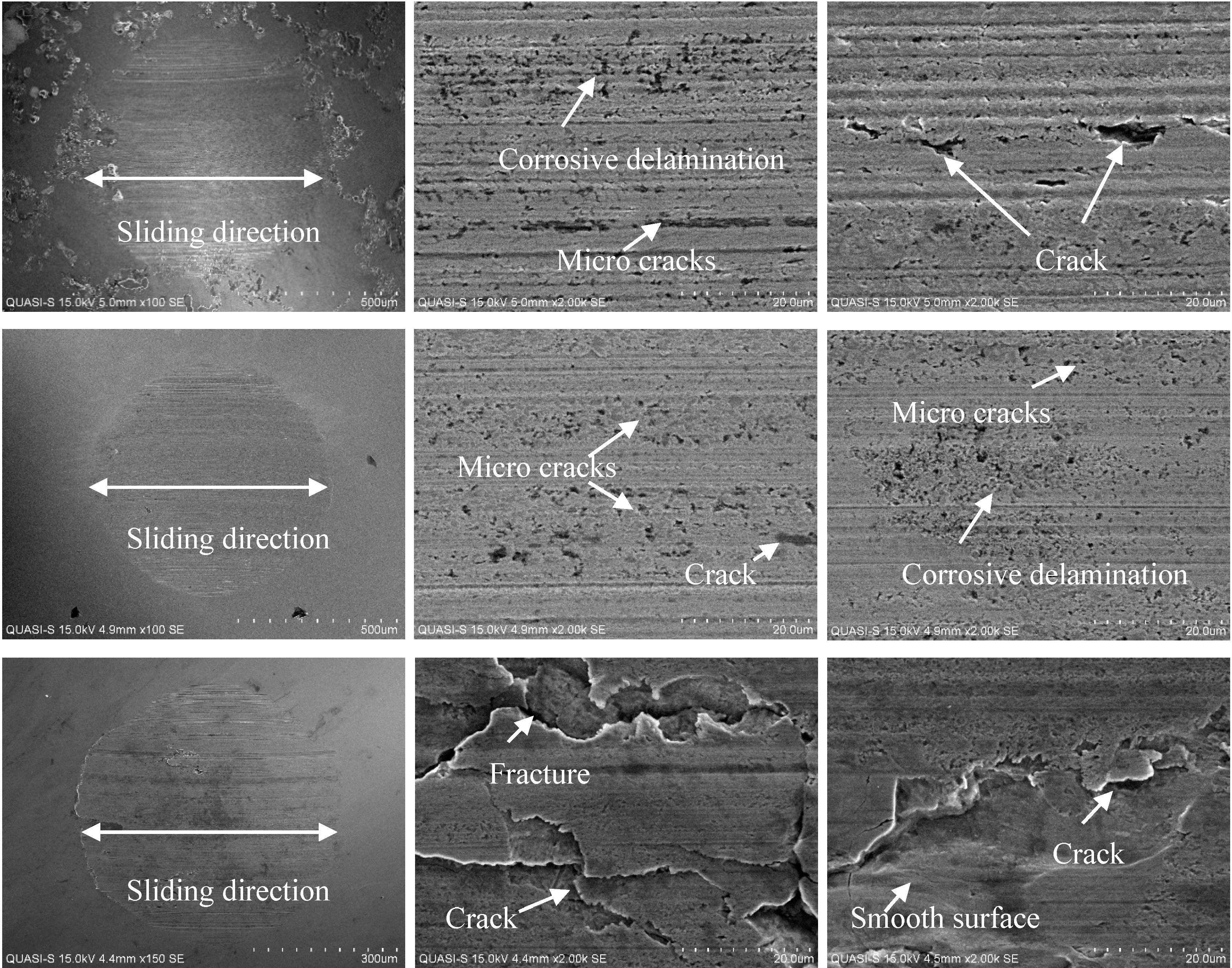
| Items | Parameters | Description |
|---|---|---|
| Specification | Speed range | 300 to 3000 rpm |
| Temperature range | 25 to 1000 °C | |
| Axial applied load | Maximum 1020 kg | |
| Scar range | 100 to 4000 micron | |
| Drive motor power | 1.50 kW | |
| Test condition | Applied load | 40 kg |
| Rotation | 1200 rpm | |
| Test duration | 3600 s | |
| Testing ball specification | Diameter of the ball | 12.70 mm |
| Materials | Carbon-chromium alloy steel | |
| Metal composition | 85.05% Fe, 10.26% C, 2.13% Zn, 1.44% Cr, 0.43% Si, 0.44% Mn, 0.09% S, 0.13% P, and 0.06% Ni | |
| Hardness of the metal | 62 HRc | |
| Surface roughness | 0.10 μm (C.L.A) | |
| Density | 7.87 gm/cm3 | |
| Tensile strength | 325,000 psi | |
| Yield strength | 295,000 psi |
| Measurements | FC | WSD | FTP | |
|---|---|---|---|---|
| Run-in Period | Steady State | |||
| Accuracy | ±0.50 | ±0.50 | ±0.01 mm | ±0.50 |
| Relative error | ±2.54 | ±1.27 | ±1.51 | ±2.76 |
| Properties | Unit | ULSD | ManCr_Pa | AvBn_Pa | Used Standard |
|---|---|---|---|---|---|
| Density (at 15 °C) | kg/m3 | 832.00 | 830.74 | 831.48 | ASTM D1298 |
| Viscosity (at 40 °C) | mm2/s | 4.10 | 3.88 | 4.10 | ASTM D445 |
| Calorific value | MJ/kg | 45.67 | 45.33 | 45.28 | ASTM D240 |
| Cetane number | - | 44.00 | 67.00 | 61:00 | ASTM D613 |
| Flash point | °C | 62.00 | 63.46 | 65.96 | ASTM D93 |
| Acid value * | mgKOH/g | - | 0.13 | 0.09 | ASTM D664 |
| Ester content * | % | - | 95.75 | 99.64 | EN 14103 |
| Iodine value * | - | - | 47.86 | 87.00 | - |
| Tested Balls | ULSD | ManCr_Pa | AvBn_Pa | |||||||||
|---|---|---|---|---|---|---|---|---|---|---|---|---|
| Major WSD mm | Minor WSD mm | Mean WSD mm | Area mm2 | Major WSD mm | Minor WSD mm | Mean WSD mm | Area mm2 | Major WSD mm | Minor WSD mm | Mean WSD mm | Area mm2 | |
| Ball 1 | 0.65 | 0.64 | 0.64 | 0.32 | 0.63 | 0.60 | 0.61 | 0.30 | 0.50 | 0.37 | 0.44 | 0.15 |
| Ball 2 | 0.68 | 0.66 | 0.67 | 0.35 | 0.63 | 0.62 | 0.63 | 0.31 | 0.51 | 0.47 | 0.49 | 0.19 |
| Ball 3 | 0.60 | 0.56 | 0.58 | 0.26 | 0.61 | 0.55 | 0.58 | 0.26 | 0.61 | 0.60 | 0.58 | 0.28 |
| Mean WSD | 0.63 mm | Mean WSD | 0.61 mm | Mean WSD | 0.51 mm | |||||||
| Element | ULSD | ManCr_Pa | AvBn_Pa | |||
|---|---|---|---|---|---|---|
| Weight % | Atomic % | Weight % | Atomic % | Weight % | Atomic % | |
| Fe | 22.90 | 6.74 | 16.57 | 4.44 | 8.97 | 2.27 |
| C | 64.87 | 81.98 | 66.11 | 79.85 | 65.24 | 75.26 |
| O | 12.03 | 11.21 | 17.23 | 15.65 | 25.84 | 22.47 |
| Cr | 0.59 | 0.21 | - | - | - | - |
| Si | - | - | 0.27 | 0.14 | - | - |
| Particle size, μm | 1.75–13.70 | 1.41–15.50 | 3.57–13.00 | |||
© 2017 by the authors. Licensee MDPI, Basel, Switzerland. This article is an open access article distributed under the terms and conditions of the Creative Commons Attribution (CC BY) license (http://creativecommons.org/licenses/by/4.0/).
Share and Cite
Azad, A.K.; Rasul, M.G.; Sharma, S.C.; Khan, M.M.K. The Lubricity of Ternary Fuel Mixture Blends as a Way to Assess Diesel Engine Durability. Energies 2018, 11, 33. https://doi.org/10.3390/en11010033
Azad AK, Rasul MG, Sharma SC, Khan MMK. The Lubricity of Ternary Fuel Mixture Blends as a Way to Assess Diesel Engine Durability. Energies. 2018; 11(1):33. https://doi.org/10.3390/en11010033
Chicago/Turabian StyleAzad, Abul Kalam, Mohammad Golam Rasul, Subhash Chandra Sharma, and Mohammad Masud Kamal Khan. 2018. "The Lubricity of Ternary Fuel Mixture Blends as a Way to Assess Diesel Engine Durability" Energies 11, no. 1: 33. https://doi.org/10.3390/en11010033





